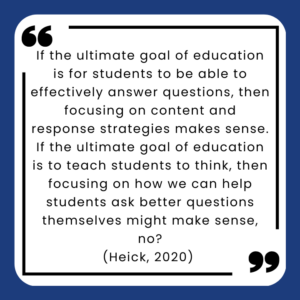Questioning has a significant impact on critical thinking and student learning. In the article, “Questioning in the Classroom: An Updated Guide,” Terry Heick outlines the strengths and weaknesses of questions. Good questions:
- Encourage further inquiry and learning
- Reveal subtleties in students’ understanding
- Promote personalized learning

(Heick, 2022). Whereas, weak questions “imply answers, which imply stopping points and ‘finishing’ over inquiry and wisdom.” We have all have been in classrooms where questions are asked and then answered one right after the other, leaving no think time or opportunity for follow-up.
According to Jackie Acree Walsh, noted author and speaker, quality questions have four characteristics:
- Connect to content,
- Are purposeful,
- Are at varied and appropriate cognitive levels
- Are clear and concise
(Walsh et al., 2018). Effective questioning takes planning on the part of the teacher with careful consideration of the instructional purpose, content, and goals of the lesson. Thoughtful scaffolding of questions during lessons enables teachers to gauge student learning and provides opportunities for feedback. “Questions are the pulse of any critical thinking classroom” (Heick, 2018). We often think of questioning techniques in a purely pedagogical sense. However, instructional materials influence the types of questions teachers use. What types of questions do your instructional materials encourage?
A mismatch between the instructional material’s approach to questioning and the district or campus philosophy could be a barrier to reaching instructional goals for two reasons. First, inexperienced teachers often rely on questions provided by their materials. Second, an inconsistency between the type of questions asked in the classroom versus the types of questions assigned as homework in the instructional material may inhibit development of critical thinking skills.

In our reviews of instructional materials, we have noted a great variation in the approach to questioning, from materials that focus on closed questions to materials that provide mostly open-ended questions. How well do your materials support critical thinking through questioning? Consider the following:
- Are there a variety of question types supporting scaffolding and differentiation?
- Do questions align to the instructional purpose and content of instruction?
- Do questions represent thinking across Bloom’s Taxonomy or Webb’s Depth of Knowledge?
- Are there open-ended questions with multiple possible answers?
- Are there opportunities for students to reflect on their strategies?
- Are there opportunities provided for student-generated questions?
- Do the teacher materials provide guidance regarding questioning, student discussions, or strategies such as think-pair-share to engage all learners?
Selecting instructional materials that align with campus or district goals for instruction support quality instruction and learning. Next time you are selecting instructional materials, consider reviewing the material’s questions adding as an indicator of quality.
Reference articles:
Heick, T. (2018, March 2) What is the Purpose of a Question, TeachThought. https://www.teachthought.com/learning/what-is-the-purpose-of-a-question/
Heick, T. (2020, November 3). An Updated Guide to Questioning in The Classroom. TeachThought. https://www.teachthought.com/critical-thinking/questioning-guide/
Heick, T. (2022, May 17). The Difference Between a Good Question and a Bad Question, TeachThought. https://www.teachthought.com/critical-thinking/the-difference-between-a-good-question-and-a-bad-question/
Walsh, J.A., Sattes, B.D., Quality Questioning: Research-Based Practices to Engage Every Learner, 2nd ed., (2016). The Main Idea (2018). https://vpaonline.org/wp-content/uploads/principal_resources/Quality_Questioning_.pdf
Walsh, J. A., Sattes, B. D., Quality Questioning: Research-Based Practices to Engage Every Learner, 2nd. Ed., The Main Idea (2018). https://vpaonline.org/wpcontent/uploads/principal_resources/Quality_Questioning_.pdf
